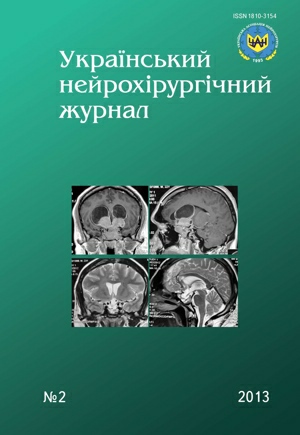Two-stage surgical treatment of giant pituitary adenomas
DOI:
https://doi.org/10.25305/unj.51875Keywords:
giant pituitary adenoma, two-stage surgery, endonasal (transsphenoidal) approach, transcranial interventionAbstract
Introduction. Surgical treatment of invasive giant pituitary adenomas (GPA) with sub- and intracranial growth is a complex problem due to a high risk of their one-stage removing. Own experience of two-stage surgical treatment of patients with GPA, needed combined surgical approaches was generalized.
Materials and methods. 9 cases of two-stage surgical treatment of patients with GPA are given. Patients’ average age was 41.3 years, there were 5 women and 4 men. 18 operations with surgical approaches combination were performed: 10 — using transsphenoidal, and 8 — transcranial approach.
Results. None of the tumor was removed radically, subtotal resection (70–90% of the tumor) was performed in 5 cases; almost full resection (more than 90%) — in 4, all patients were alive. Complications and their course in early postoperative period were described.
Conclusions. Two-stage surgical treatment of patients with GPA is effective and provides long-term clinical results. Combination of transcranial and transsphenoidal approaches for GPA removing permits to use advantages of both.
References
1. Patsko YaV. Adenomy gipofiza s obshirnym ekstrasellyarnym raspostraneniyem [Pituitary adenomas with extensive proliferation ekstrasellyarnym] [dissertation]. Kiev (Ukraine): Ukrainian Research Institute of Neurosurgery; 1987. Russian.
2. Symon L, Jakubowski J, Kendall B. Surgical treatment of giant pituitary adenomas. J Neurol Neurosurg Psychiatry. 1979 Nov;42(11):973-82. [PubMed] [CrossRef]
3. Mortini P, Barzaghi R, Losa M, Boari N, Giovanelli M. Surgical treatment of giant pituitary adenomas: strategies and results in a series of 95 consecutive patients. Neurosurgery. 2007 Jun;60(6):993-1002; discussion 1003-4. [PubMed] [CrossRef]
4. Wilson CB. A decade of pituitary microsurgery. The Herbert Olivecrona lecture. J Neurosurg. 1984 Nov;61(5):814-33. [PubMed] [CrossRef]
5. D'Ambrosio AL, Syed ON, Grobelny BT, Freda PU, Wardlaw S, Bruce JN. Simultaneous above and below approach to giant pituitary adenomas: surgical strategies and long-term follow-up. Pituitary. 2009;12(3):217-25. [PubMed] [CrossRef]
6. Patsko IaV. [Surgical tactics in recurring pituitary adenomas]. Klin Khir. 1981 Dec;(12):22-6. Russian. [PubMed]
7. Kadashev BA, Trunin IuK, Kornienko VN, Kalinin PL. [The staged use of transcranial and transphenoidal surgical approaches in treating hypophyseal adenomas]. Zh Vopr Neirokhir Im N N Burdenko. 1996 Oct-Dec;(4):6-10. Russian. [PubMed]
8. Barrow DL, Tindall GT. Combined simultaneous transsphenoidal transcranial operative approach to selected sellar tumors. Perspect Neurol Surg. 1992;(3):49.
9. Alleyne CH Jr, Barrow DL, Oyesiku NM. Combined transsphenoidal and pterional craniotomy approach to giant pituitary tumors. Surg Neurol. 2002 Jun;57(6):380-90; discussion 390. [PubMed] [CrossRef]
Downloads
Published
How to Cite
Issue
Section
License
Copyright (c) 2013 Oleksandr Voznyak, Oleg Maydannyk

This work is licensed under a Creative Commons Attribution 4.0 International License.
Ukrainian Neurosurgical Journal abides by the CREATIVE COMMONS copyright rights and permissions for open access journals.
Authors, who are published in this Journal, agree to the following conditions:
1. The authors reserve the right to authorship of the work and pass the first publication right of this work to the Journal under the terms of Creative Commons Attribution License, which allows others to freely distribute the published research with the obligatory reference to the authors of the original work and the first publication of the work in this Journal.
2. The authors have the right to conclude separate supplement agreements that relate to non-exclusive work distribution in the form of which it has been published by the Journal (for example, to upload the work to the online storage of the Journal or publish it as part of a monograph), provided that the reference to the first publication of the work in this Journal is included.









